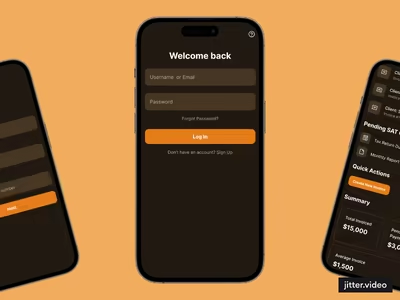Redesigning the Leasing Experience for Inverfin
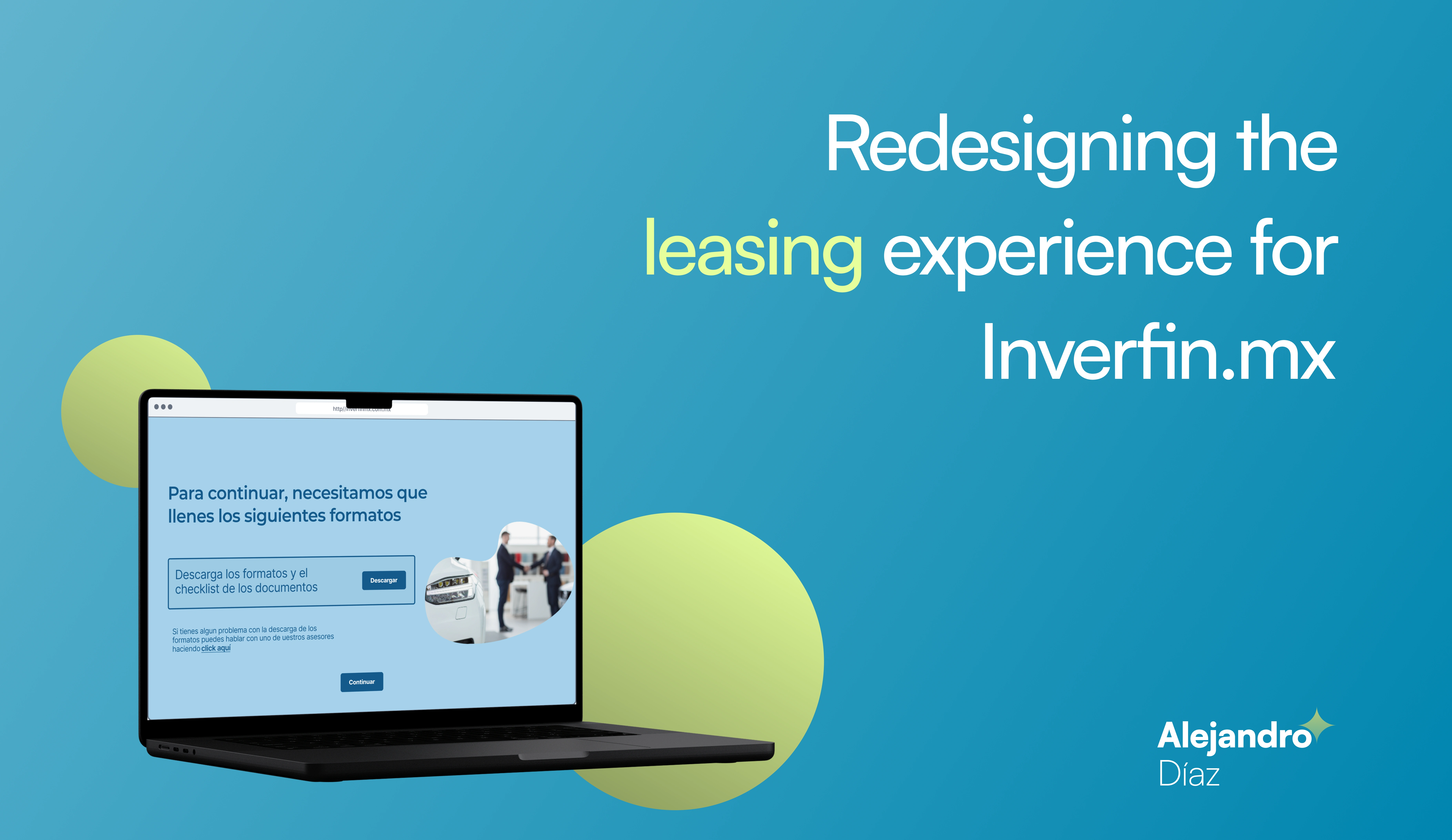
Revolutionizing Leasing: Slashing Application Times by 30%: Inverfin
Inverfin, a key player in Small and Medium Enterprise financing, recognized a critical bottleneck hindering its growth and that of its clients: the traditional equipment leasing process. This manual, often paper-based system was slow, opaque, and cumbersome, creating significant friction for the very businesses Inverfin aimed to empower. Recognizing the need for transformation, this project focused on redesigning the entire leasing journey into a user-centric digital platform. The result was a streamlined experience that delivered a 30% reduction in average application submission time, unlocking faster funding access for SMEs and significantly boosting Inverfin's operational efficiency.1 This case study details the journey from identifying deep-seated user frustrations to launching an impactful digital solution.

The Bottleneck: Why Inverfin's Manual Leasing Process Stifled SME Growth
The existing leasing process at Inverfin presented significant challenges for both the company and its SME clients. Before this initiative, applying for equipment leasing was characterized by:
Excessive Lead Times: SMEs often waited weeks for application processing and decisions. This delay directly impacted their ability to acquire necessary equipment promptly, potentially stalling growth or causing them to miss business opportunities – a critical issue for businesses needing agility.
Cumbersome Paperwork: Applicants faced complex forms requiring extensive information, often demanding manual completion and physical submission. This administrative burden was a major pain point for time-poor SME owners and managers who often juggle multiple roles.
Lack of Transparency: Once submitted, applications entered a 'black box'. SMEs had little to no visibility into the status of their application, the criteria being assessed, or expected timelines. This opacity bred anxiety and frustration, particularly for businesses carefully managing cash flow and needing predictability.
High Internal Overhead: For Inverfin, the manual process involved significant staff effort in data entry, document verification, chasing missing information, and providing manual status updates. This inefficiency limited scalability and increased operational costs.
User Frustration and Abandonment: The combination of delays, complexity, and lack of transparency led to high levels of user frustration. Consequently, a significant number of SMEs abandoned their applications midway, representing lost business for Inverfin and unmet needs for potential clients.
These process flaws were particularly detrimental given the known financial pressures on SMEs, such as managing tight cash flows, securing timely access to capital for growth or operations, and minimizing administrative overhead to stay competitive. The manual leasing process, rather than facilitating SME success, was inadvertently acting as a barrier. This highlighted a clear need for a fundamental redesign focused on the user experience.
Charting the Course: Aligning User Needs and Business Goals for a Seamless Experience
To address the identified problems, the project established clear goals that bridged the gap between SME user needs and Inverfin's strategic business objectives.
Project Goals:
For Users (SMEs): Significantly reduce the time, effort, and complexity involved in applying for and managing equipment leases. Enhance transparency throughout the process to build trust and reduce uncertainty.
For Business: Increase the efficiency and scalability of the leasing application process. Reduce operational costs associated with manual handling. Improve SME client satisfaction, leading to increased retention and potentially attracting new clients.
Success Metrics (KPIs):
To measure progress towards these goals and evaluate the final solution's effectiveness, specific, measurable Key Performance Indicators (KPIs) were defined upfront. Plausible baseline data (based on estimates of the previous manual process) and ambitious yet achievable targets were set.1
Establishing these metrics provided clear criteria for success and guided the design and development process, ensuring efforts remained focused on achieving tangible, measurable improvements for both users and the business.12
My Role: Driving the UX Transformation
As the Lead UX Designer on this 6-month engagement, I held primary responsibility for shaping the end-to-end user experience strategy and design of the new digital leasing platform. My key activities encompassed:
User Research: Planning and conducting qualitative research (user interviews) and competitor analysis.
Synthesis & Strategy: Analyzing research data, identifying key insights, developing user archetypes (personas), and mapping the customer journey to pinpoint critical pain points. Defining the core design principles based on these findings.
Design: Creating low-fidelity sketches, detailed wireframes, user flows, and high-fidelity interactive prototypes for the platform.
User Testing: Planning, scripting, recruiting for, facilitating, and analyzing moderated usability testing sessions.
Iteration: Refining designs based on user feedback and technical feasibility discussions.
Collaboration: Working closely and continuously with product managers to align with business requirements and with the engineering team to ensure designs were technically feasible and implemented accurately.
This project was a collaborative effort involving product management, engineering, and business stakeholders from Inverfin. My focus was ensuring the user's voice was central to every decision, translating their needs and Inverfin's goals into an intuitive and effective digital solution.
Understanding the Users: Uncovering SME Pain Points Through Research
A deep understanding of the target users – SME owners and managers – was fundamental to designing an effective solution. A multi-faceted research approach was employed to uncover their specific needs, behaviors, and frustrations related to the equipment leasing process.
Digging Deeper: Our Research Approach
The following methods were selected to gather comprehensive insights:
User Interviews (Owners/Managers): Semi-structured interviews were conducted with participants representing a mix of industries, company sizes, and levels of experience with leasing. This qualitative method was chosen to delve deep into their experiences with financing, understand their workflows, uncover specific pain points with the existing Inverfin process (or similar processes), and capture their emotional responses and unmet needs.12 The goal was to gather rich, contextual stories beyond surface-level feedback.
Competitor Analysis: An analysis of digital leasing and financing platforms offered by direct competitors and analogous services was performed. This helped identify existing market standards, common features, potential usability benchmarks, and opportunities for Inverfin to differentiate its offering through a superior user experience.12
Existing Data Analysis (Internal): Available internal Inverfin data related to the previous leasing process was reviewed. This included analyzing application drop-off points, common reasons for customer support calls regarding leasing, and internal data on average processing times. This quantitative data helped validate and quantify the problems identified in interviews.12
This combination of qualitative and quantitative methods provided a holistic view, ensuring design decisions were grounded in both empathetic understanding and objective data.8
Voices of the SMEs: Key Insights & User Archetypes
The research yielded several critical findings that shaped the project direction:
Speed is Paramount: For many SMEs, particularly those in fast-moving sectors, the speed of accessing funds for equipment is crucial. Delays directly impact operations and revenue potential.
Transparency Builds Trust: SMEs expressed significant frustration with opaque financial processes. They need clear, upfront information about costs, terms, requirements, and application status to make informed decisions and feel secure.
Simplicity Reduces Burden: Complex forms and administrative processes are major deterrents for time-constrained SME owners and managers. They value simplicity and efficiency.
Management Needs Vary: While some apply for leases infrequently, others (especially in sectors like construction or logistics) manage multiple leases concurrently and require tools for efficient oversight.
These insights were synthesized into three user archetypes (personas) to represent the key user groups and guide design decisions:
Gabriela (The Efficiency-Focused Owner): Runs a rapidly growing catering business. Needs new kitchen equipment and delivery vans now to capitalize on opportunities. She is tech-savvy but extremely time-poor.
Goals: Secure leasing quickly with minimal paperwork and hassle. Know costs and timelines upfront.
Pain Points: Hates lengthy forms, opaque processes, and waiting weeks for decisions. Finds delays directly impact her ability to serve clients.
Quote: "Every day I wait for financing approval is a day I might lose a big contract. I need fast, simple, no-surprises."
Rodrigo (The Detail-Oriented Planner): Owns a small, established manufacturing workshop. He is meticulous about finances, compares options carefully, and is wary of hidden costs or complex terms.
Goals: Fully understand all lease terms, costs, and implications before committing. Feel confident and secure in the financial arrangement. Easily compare options if needed.
Pain Points: Finds financial jargon confusing and processes lacking transparency. Worries about unexpected fees or contractual obligations. Needs clear documentation.
Quote: "I need to see the full picture – interest rates, payment schedules, buyout options – all laid out clearly. No nasty surprises down the line."
Jaime (The Multi-Tasking Manager): Manages operations for a mid-sized construction company, responsible for acquiring and tracking numerous leased assets (vehicles, heavy machinery, office equipment).
Goals: Efficiently manage multiple lease applications and active leases from a single interface. Track assets, payments, and contract end dates easily. Receive timely reminders.
Pain Points: Current processes are fragmented, requiring tracking across spreadsheets and emails. Difficulty getting a quick overview of all leased assets and obligations. Time wasted chasing information.
Quote: "I'm managing leases for excavators, trucks, office gear... I need one place to see everything, track payments, and know when contracts are ending."
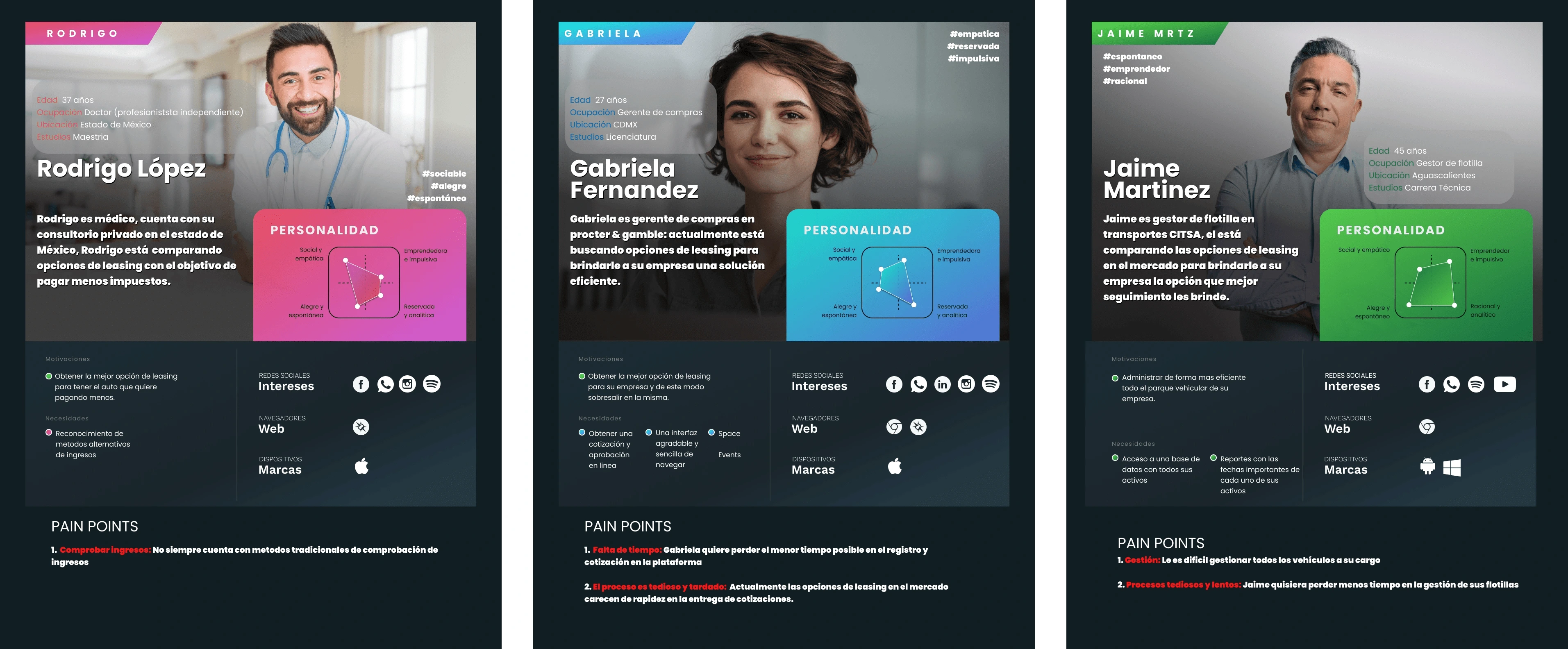
These archetypes served as constant reminders of the diverse needs and challenges the new platform needed to address.
Mapping the Friction: The SME Leasing Journey
To visualize the user experience with the original process and pinpoint specific areas for improvement, a customer journey map was created.15 This map synthesized findings from interviews and data analysis, charting the typical steps, actions, thoughts, and emotional states of users like Gabriela, Rodrigo, and Jaime as they navigated the leasing process from initial inquiry to final approval (or abandonment).
Key friction points identified on the map included:
Initial Information Gathering: Difficulty finding clear, concise information about lease options and requirements online.
Application Submission: Overly complex and lengthy application forms, uncertainty about required documentation.
Document Submission: Cumbersome process for submitting supporting documents (often via email or post), lack of confirmation upon receipt.
Waiting Period: Long, opaque waiting times for credit checks and approval, with no proactive status updates (major pain point for Gabriela).
Communication: Reactive rather than proactive communication from Inverfin, often requiring SMEs to chase for updates (frustrating for Rodrigo and Jaime).
Lack of Centralization: Difficulty managing multiple applications or existing leases (critical for Jaime).
This map provided a powerful, shared understanding of the existing user experience challenges and clearly highlighted the moments that mattered most, guiding the prioritization of design efforts.28
From Insights to Interaction: Designing an Efficient and Transparent Leasing Platform
The research phase provided a clear mandate: transform the cumbersome leasing process into a digital experience centered on efficiency, transparency, and control for SMEs. The design process focused on translating these user needs into an intuitive and valuable platform.
Setting the Direction: How Research Shaped Our Design Strategy
Based on the key research insights, persona needs, and journey map friction points, the following core principles guided the design strategy 8:
Efficiency First: Design every interaction to minimize user effort and time. This meant streamlining workflows, simplifying forms, automating steps where possible, and providing clear navigation – directly addressing Gabriela's need for speed and the general time constraints of SMEs.2
Radical Transparency: Ensure users have clear visibility at every stage. This involved providing real-time status updates, upfront cost breakdowns, easy access to terms and conditions, and using clear, jargon-free language – crucial for building trust with users like Rodrigo.6
User Control & Flexibility: Empower users with control over their information and applications. This included features like saving application progress, managing documents online, and providing a centralized hub for users like Jaime managing multiple leases.10
Accessible Support: While aiming for self-service, ensure help is readily available through contextual guidance, FAQs, and easy access to human support channels if users get stuck.
These principles acted as a compass, ensuring that subsequent design decisions remained aligned with solving the core user problems identified in the research phase.
Sketching the Future: Ideation & Wireframing Key Flows
The design process began with ideation sessions and sketching, exploring various approaches to structuring the platform and key interactions. These initial concepts were then translated into digital wireframes, focusing on information architecture, layout, and core user flows without the distraction of visual styling.8 Key flows prioritized for wireframing included:
The Streamlined Application Form: Wireframes focused on breaking the application into logical, manageable steps, using progress indicators, incorporating clear field labels and instructions, providing contextual help, and enabling a 'save and continue later' functionality. This directly tackled the complexity and length identified as major friction points, especially for Gabriela.
The Transparent Status Dashboard: This central hub was designed to give users like Rodrigo and Jaime an immediate overview upon login. Wireframes detailed how application statuses (e.g., 'Documents Required', 'Under Review', 'Approved'), active leases, required actions, and estimated timelines would be clearly displayed.
The Lease Management Hub: For users like Jaime managing multiple assets, wireframes outlined a dedicated section to view details of all active leases, track payment history, manage associated documents, and see upcoming contract milestones like renewal dates.

These wireframes served as blueprints, facilitating discussions with stakeholders and the engineering team about feasibility and ensuring the core structure addressed the strategic principles before investing in detailed visual design.
Crafting the Interface: Building Trust and Usability with Inverfin's Brand
The User Interface (UI) design phase focused on creating a visually appealing, professional, and trustworthy experience that reflected Inverfin's brand identity while maximizing usability. Key considerations included:
Brand Alignment: The visual design incorporated Inverfin's existing color palette, typography, and logo, but applied them within a modern, clean, and accessible interface framework. The goal was to feel familiar yet significantly improved.
Usability & Clarity: Visual hierarchy was used to guide users' attention to key information and actions. Consistent layout patterns, clear typography, and ample white space were employed to enhance readability and reduce cognitive load. Interactive elements were designed to be easily identifiable and provide clear feedback.
Building Trust: For a financial application, conveying security and reliability was paramount.6 This was achieved through a professional aesthetic, clear labeling of secure sections (like document upload), prominent display of contact/support information, and avoiding overly flashy or distracting elements. A mini-style guide was developed to ensure consistency across the platform.31
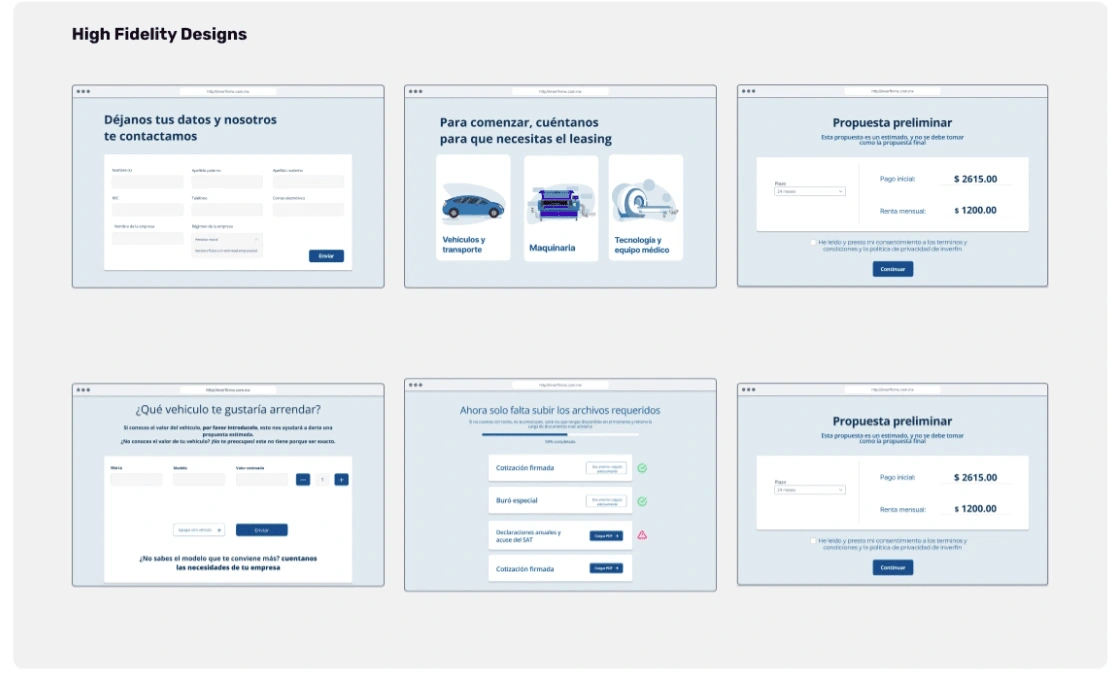
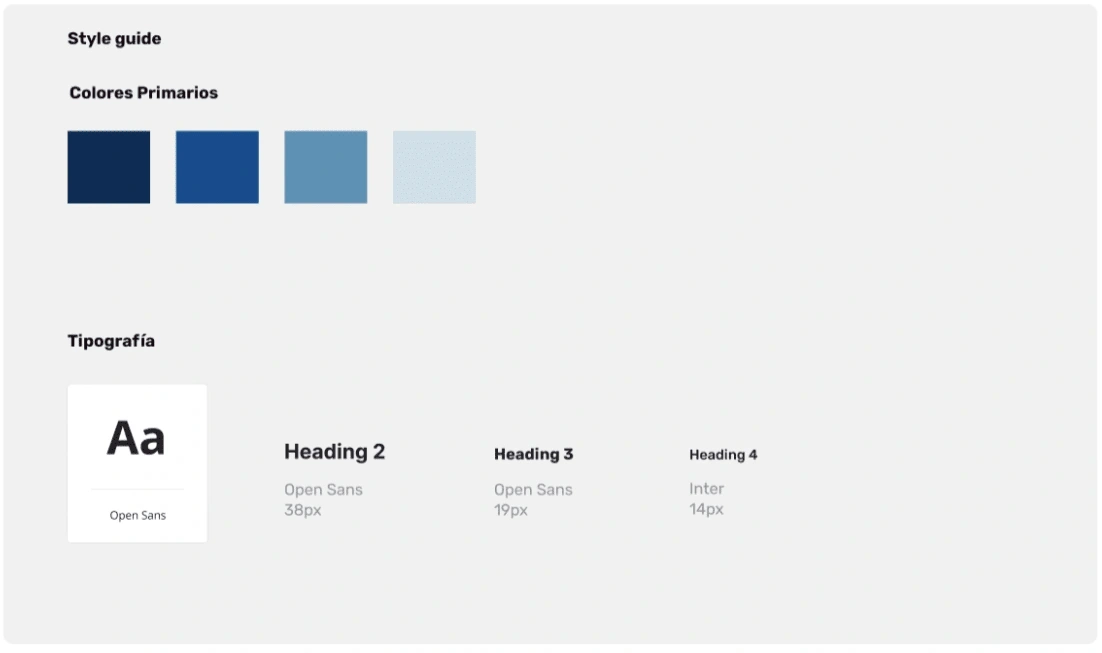
The UI aimed not just to be functional but to create a positive and confidence-inspiring impression, reflecting the seamless experience SMEs expect from modern digital services.6
Refining Through Feedback: Iterating Based on User Testing
Before finalizing the design, usability testing was conducted to validate assumptions and identify areas for refinement.12
Methodology: Moderated Remote Usability Testing was chosen to allow for observation of user behavior in their natural context while enabling real-time probing questions.17 Eight participants, carefully screened to match the key characteristics of Gabriela (3), Rodrigo (3), and Jaime (2), were recruited. Sessions were conducted via video conferencing using screen sharing, with interactions and feedback captured using Maze.
Tasks Tested: Participants were asked to complete core tasks reflecting the primary goals of the platform 17:
Start a new equipment lease application and complete the initial information section.
Find and understand the required documents for the application.
Upload a sample document.
Locate the status of a hypothetical pending application on the dashboard.
Find the payment schedule for a hypothetical active lease.
Critical Findings & Iterations: Several usability issues were uncovered, leading to targeted design iterations.
The Solution: A Streamlined Digital Leasing Experience for Inverfin's SMEs
The culmination of the research, design, and iteration process was a modern, user-friendly digital platform designed to transform Inverfin's SME leasing experience.
Empowering SMEs: Key Features and Functionality
The final solution delivered a suite of features focused on efficiency, transparency, and control:
Intuitive Online Application: A step-by-step digital form replacing complex paperwork, featuring progress saving, clear instructions, and reduced fields.
Personalized User Dashboard: A central hub providing SMEs with an at-a-glance overview of their application statuses, active leases, outstanding tasks, and important notifications.
Real-time Application Status Tracking: A visual progress bar and status updates, eliminating the 'black box' and providing clarity on where an application stands in the process.
Secure Document Upload & Management: An integrated portal for easily uploading and managing required documents electronically, with confirmations and clear labeling.
Transparent Cost Calculator & Summary: Tools providing clear breakdowns of estimated costs, rates, and terms directly within the application flow.
Lease Management Tools: Functionality for users with multiple leases to view payment history, track asset details, access contract documents, and receive automated reminders for payments or renewals.
Contextual Help & Support: Integrated help icons, a searchable FAQ section, and clear pathways to contact Inverfin support staff when needed.
These features collectively aimed to remove the friction points identified in the original process and provide a vastly improved experience.
Tailored for Success: Addressing the Needs of Gabriela, Rodrigo, and Jaime
The platform was specifically designed to cater to the distinct needs of the identified user archetypes 11:
For Gabriela: The streamlined application flow, minimal data entry requirements, quick document upload feature, and real-time status updates directly addressed her need for speed and reduced administrative burden, allowing her to secure financing faster.
For Rodrigo: The transparent status dashboard, clear cost breakdowns presented upfront, easily accessible terms and conditions within the platform, and the overall professional and secure interface provided the clarity and confidence he required to make informed decisions.
For Jaime: The centralized dashboard offering a consolidated view of all applications and leases, the ability to track assets and payments, and automated reminders significantly simplified the management of multiple leases, saving him valuable time and reducing administrative overhead.
By tailoring the solution to these core user needs, the platform aimed to deliver significant value across Inverfin's diverse SME client base.
Measurable Impact: Driving Efficiency and Business Value
The launch of the redesigned digital leasing platform yielded significant positive results, validating the user-centered design approach and delivering tangible value to both SMEs and Inverfin.
Hitting the Mark: Performance Against Success Metrics
Post-launch monitoring and data collection showed marked improvements against the initial success metrics:
Application Time: Average end-to-end application submission time (from initiation to submission of all required info online) was reduced by 30%, meeting the project target and significantly speeding up access to finance for SMEs.
Completion Rate: The online application completion rate increased from an estimated 60% to 75%, a 25% increase that met the target. This indicated significantly improved usability and reduced user frustration.
User Satisfaction (CSAT): Post-application survey scores averaged 4.6 out of 5, exceeding the target of 4.5 and demonstrating a high level of satisfaction with the new process.
Usability (SUS): The platform achieved an average System Usability Scale score of 78, placing it well above the industry average score of 68 and surpassing the target of 75+, confirming its perceived ease of use.
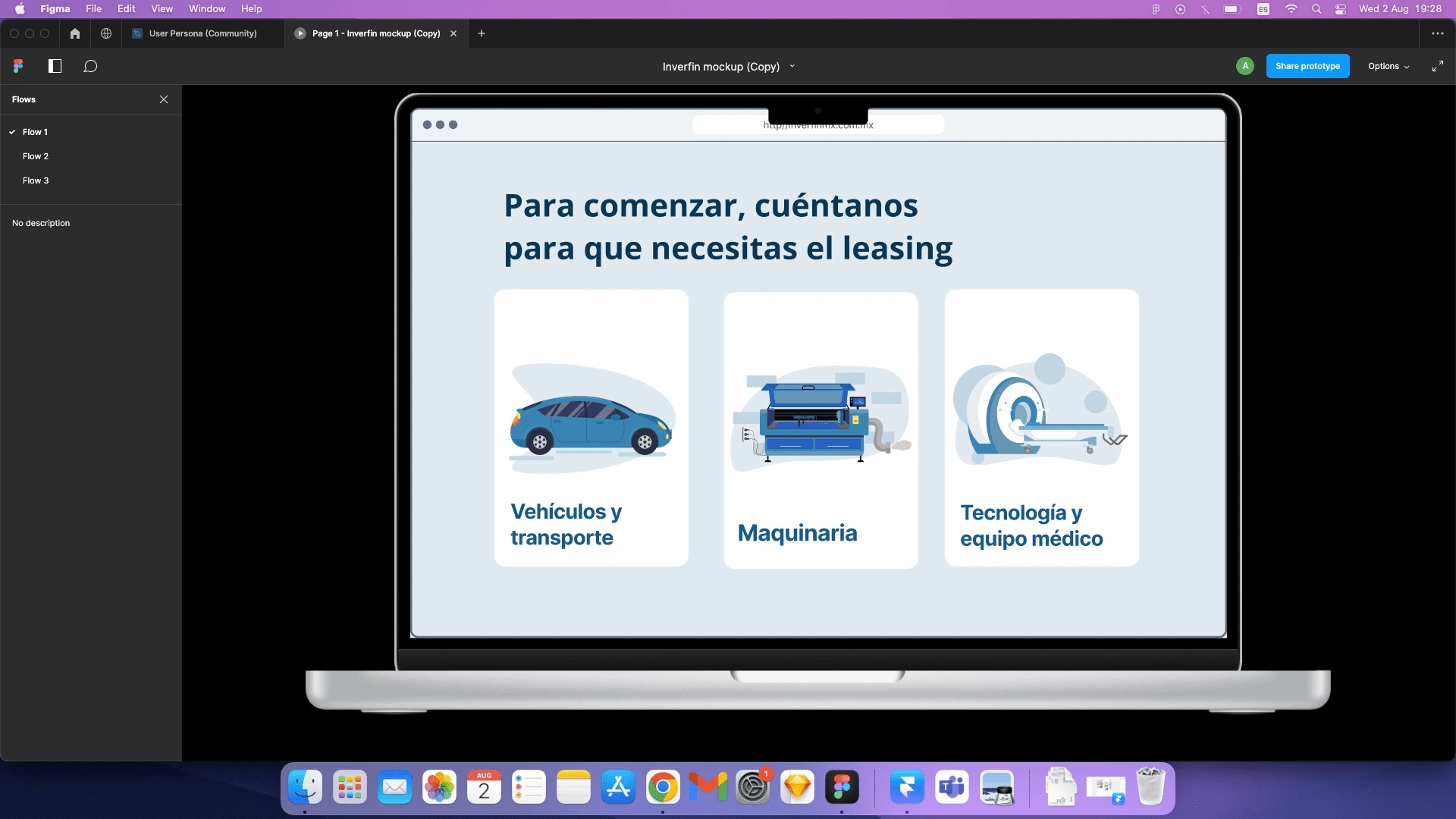
These quantitative results provided clear evidence that the redesigned platform successfully addressed the core usability and efficiency issues of the previous process.9
Beyond the Numbers: Qualitative Wins and Stakeholder Acclaim
Qualitative feedback further reinforced the positive impact of the new platform:
User Feedback: SMEs consistently praised the platform's ease of use and speed. An indicative quote from a user resembling the 'Gabriela' archetype: "The new online application was a lifesaver! I submitted everything in one evening and got my approval much faster than expected. So much simpler than the old way." Users like 'Rodrigo' appreciated the clarity: "Finally, I could see exactly where my application was and what was needed next. The cost summary was also very helpful."
Stakeholder Feedback: Internal Inverfin teams also reported benefits. A comment from a leasing operations manager: "The digital platform has significantly reduced the manual data entry and follow-up required from our team, freeing them up to handle more complex inquiries and build stronger client relationships."
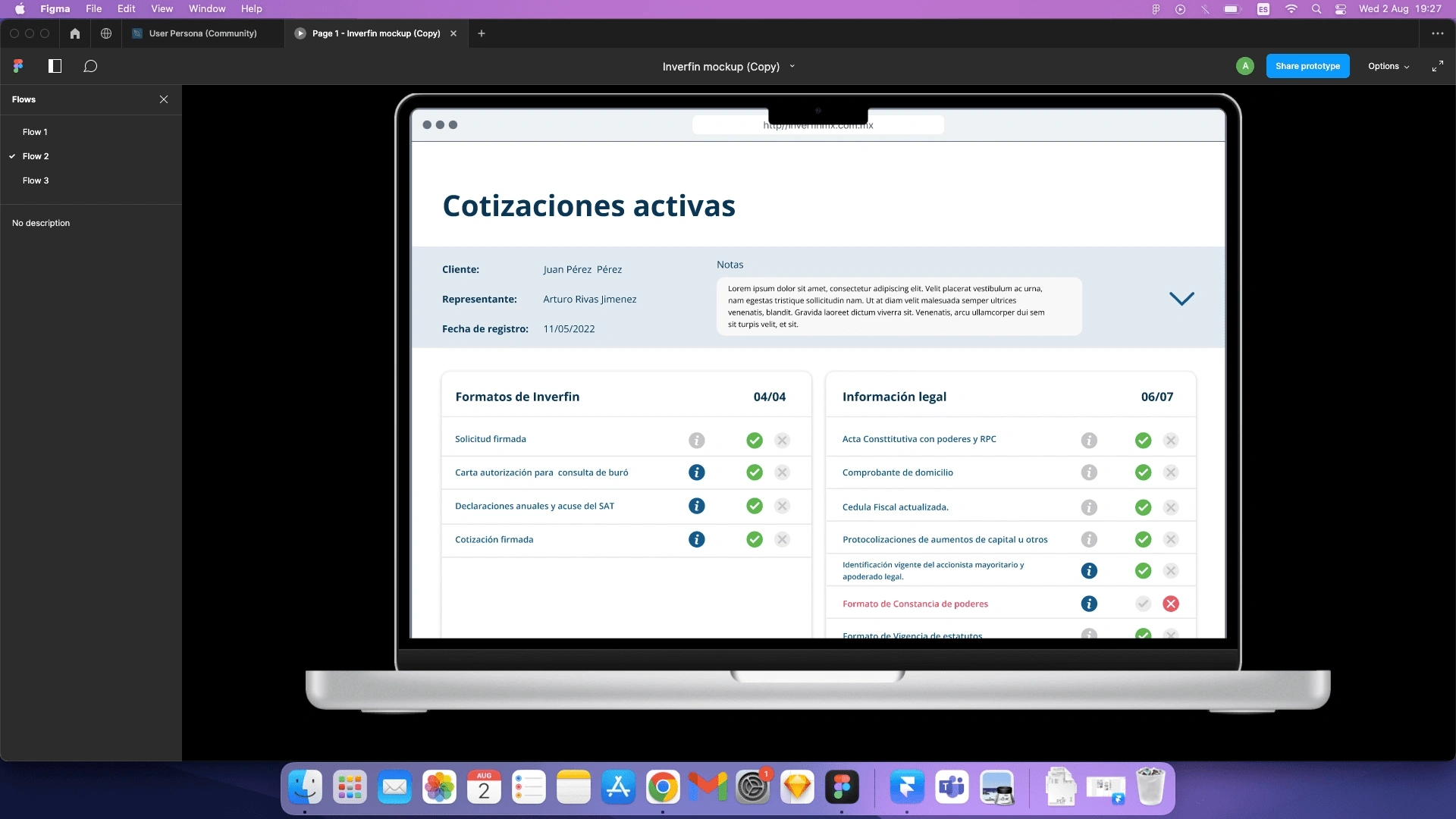
This qualitative evidence highlighted the human impact of the design changes, complementing the metrics and showing improved experiences for both external and internal users.
The Bottom Line: Business Value Delivered to Inverfin
The UX improvements translated directly into significant business value for Inverfin 1:
Improved Operational Efficiency: The 30% reduction in application time and automation of tasks like document collection and status updates led to lower administrative costs and increased processing capacity for the leasing team.
Increased Business Throughput: The 25% increase in application completion rates directly translated to a larger pipeline of potential lease agreements, boosting business volume.
Enhanced Competitiveness: Offering a modern, efficient, and transparent digital experience positioned Inverfin more favorably against competitors still relying on slower, manual processes, helping attract and retain tech-savvy SMEs.
Improved Customer Loyalty: Higher satisfaction scores (CSAT) and a more positive user experience are strong indicators of increased customer loyalty and potential for repeat business and referrals.
Foundation for Growth: The scalable digital platform provided a foundation for Inverfin to grow its SME leasing portfolio more effectively.
This project demonstrated that investing in a user-centered design process can yield substantial returns, driving not only user satisfaction but also core business objectives like efficiency, growth, and market positioning.
Reflections and Future Directions: Lessons Learned and Next Steps
The successful launch of the Inverfin SME leasing platform provided valuable learnings and highlighted opportunities for future enhancements.
Key Project Takeaways
Several key lessons emerged from this engagement:
Transparency is Non-Negotiable for SMEs: The research and testing phases consistently highlighted how crucial transparency is in financial processes for SMEs. Providing clear status updates, cost breakdowns, and accessible terms was fundamental to building trust and reducing user anxiety, particularly for careful planners like Rodrigo.
Efficiency Needs Context: While speed was vital for users like Gabriela, efficiency also meant different things to different users. For Jaime, efficiency meant centralized management and oversight. Designing for efficiency required understanding these varied contexts.
Early Technical Collaboration is Crucial: Engaging closely with the engineering team early on helped identify technical constraints and opportunities, ensuring design solutions were feasible and allowing for proactive problem-solving around integration challenges.
Navigating Challenges and How We Overcame Them
No project is without obstacles. A significant challenge was integrating the new front-end platform with Inverfin's existing legacy backend systems, which had limitations in providing truly real-time data for the application status tracker.
How We Overcame It: Instead of aiming for perfect real-time updates which were technically unfeasible initially, we worked closely with engineering to define the most frequent possible data synchronization points. Crucially, the UI was designed to manage user expectations by clearly indicating the timestamp of the 'last update' for the application status. This pragmatic approach balanced user desire for transparency with technical reality, preventing user frustration that might arise from assuming outdated information was live.
Looking Ahead: Opportunities for Future Improvement
While the initial launch was successful, several opportunities exist for future enhancements based on project learnings and evolving user needs:
Mobile Application: Developing a dedicated mobile app could further enhance accessibility and convenience for busy SME owners on the go.
Accounting Software Integration: Integrating the platform with popular SME accounting software (like QuickBooks, Xero) could streamline financial reconciliation, a known pain point for many small businesses.
Enhanced Reporting: Providing more sophisticated reporting and analytics tools within the lease management hub could offer greater value to users like Jaime managing larger portfolios.
Proactive Renewal Management: Implementing features to proactively alert users about upcoming lease expirations and offer streamlined renewal options.
Like this project
Posted Aug 3, 2023
Redesigned Inverfin's leasing experience to streamline processes for users, addressing pain points & improving efficiency. User-centered design approach.
Likes
1
Views
65
Timeline
Dec 3, 2023 - Dec 9, 2024
Clients

Inverfin






